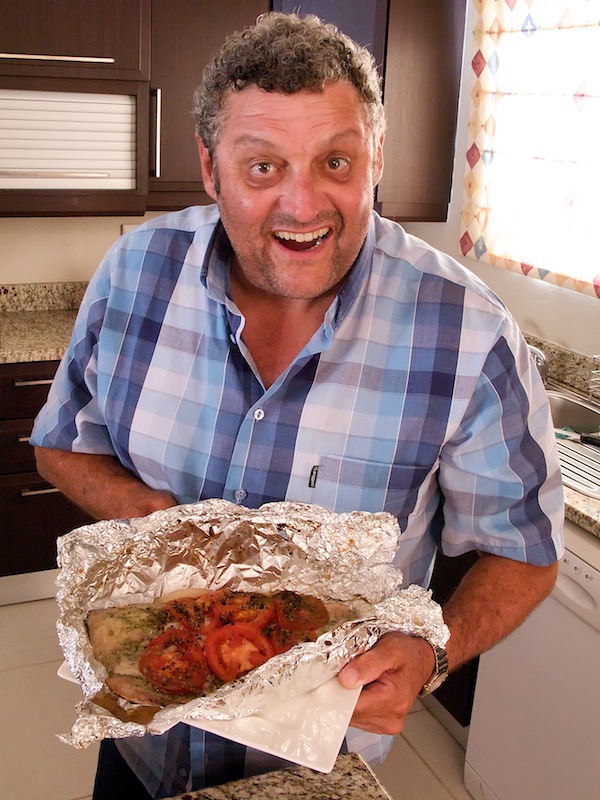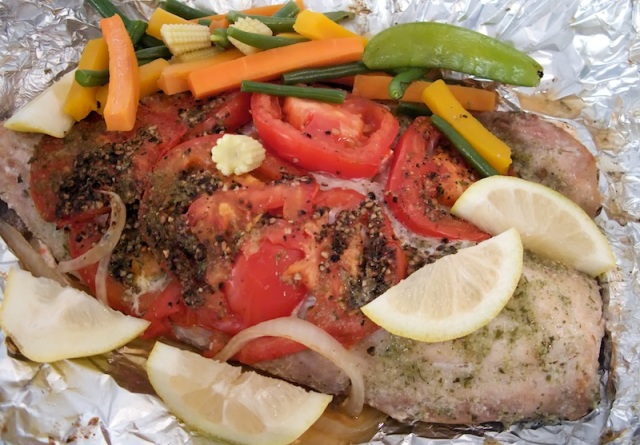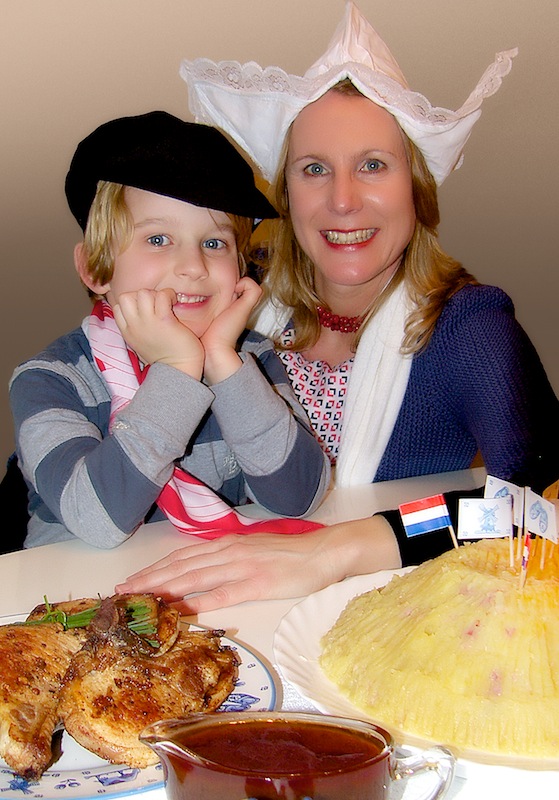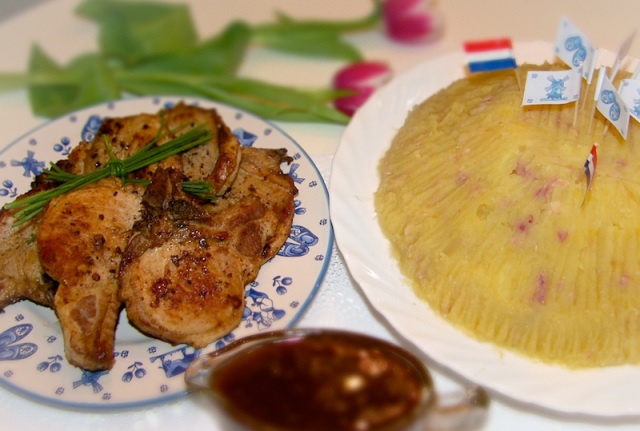Welcome to the first in our series of cooking for the World Cup! Each week we will feature at least two recipes from the 32 countries which will be heading to South Africa in June for the 2010 Fifa World Cup! Ladu……ma! However when it comes to South Africa we’ll cheat a bit, as there are such diverse culinary traditions in this country. So, expect to see at least three more South African recipes in the weeks to come!
Our first guest is The Cousin, that beloved South African comedian Barry Hilton, who lives in Port Elizabeth and is married to Louise’s dear friend Sandy. A keen fisherman (who always lets the fish he’s caught go because he feels sorry for them!) Barry has a hilarious new show called Fresh Catch – and he’s chosen a recipe to tie in with this theme. See the video demonstration above of Barry preparing a simple and delicious fresh yellowtail dish above – and scroll down for the recipe! Keep scrolling down, as after that Louise’s sister Kaylene Vrijburg, who lives in Holland, shares a recipe for a favourite traditional Dutch dish.

Picture: Salvelio Meyer

Picture: Salvelio Meyer
Recipe: Barry’s Steamed Yellowtail
Ingredients
1kg fresh Yellowtail fillet; 3 biggish ripe tomatoes, sliced; 1 medium onion, thinly sliced; juice of one lemon (no bottled juice please!); salt and freshly-ground black pepper; fish spice.
Method
Preheat the oven to 180 degrees Celsius. Take a double layer of heavy aluminium foil and pile half of the tomatoes and onions on it; season. Spread it out a bit, then position the fish on top of it. Season the fish, including with some fish spice, then pile the rest of the tomatoes and onion on top and season these too. Finish off with the fresh lemon juice and seal the foil parcel in the way you’d wrap school samies, leaving a bit of a gap though so some of the steam can escape.
Bake at 180 degrees for about half an hour; if not completely done then leave it in a little longer, as cooking time also depends on how thick the fillet is. Do take care, however, not to overcook the fish. Serve with herby new potatoes and steamed veggies.
World Cup Cook-off: The Netherlands

Kaylene and young son Onno Jnr.
Louise’s sister Kaylene Vrijburg has lived in Holland 12 years – 11 as an expat and one as a Dutch citizen. Adjusting to the country’s cuisine and culture took some doing at first – “especially learning all those names in Dutch when most of them could not be found in a dictionary”, she chuckles.
“I made two bloopers in the beginning: I found something interesting called ‘paardenrookvlees’ which truly horrified my half-Dutch husband, as it turned out to be smoked horse meat!” She once also ordered “lamszwezerik” in a restaurant. “Well! If you’re not into eating the thymus of fluffy little lambs, this is definitely not something you should ever order…”
Cooking times were another huge adjustment. Most parts of Holland are between two and six metres below sea level, which significant affects the amount of time spent in the kitchen. Spaghetti cooks in just nine minutes! Statistically speaking, the Dutch on average spend the least amount of time cooking in Europe, at just 40 minutes per day!
Recipe: Hete Bliksem (traditional)

Kaylene has learned a lot about traditional Dutch cooking during her time in Holland, especially from the Vrijburgs’ beloved family friend, Emmy de Ruiter, who shared today’s recipe with us.
The background on Hete Bliksem is fairly sketchy, with at least three Dutch provinces claiming to have originated the recipe: Friesland, Brabant and Groningen. What is known is that the potato became very popular during the 1700s because of high wheat prices. It was soon transformed into a practical winter food in the form of ‘stamppot’.
Other forms of the dish include stamppot bruine bonen, zuurkool stamppot, stamppot groenekool, andijvie stamppot and hutspot (which is similar to the South African wortelbredie).
Emmy and her partner both remember eating Hete Bliksem quite frequently during the Second World War, because the ingredients were cheap and readily available. Of course, says Kaylene, they would not have had pork chops with it, but “errr … other stuff like cats and dogs, and horses, as there was a huge food shortage then”!
Kaylene says the bacon they use in Holland is pretty thick, and once it’s been boiled for half and hour, they add it in with the potatoes and boil it together for another half an hour. South Africans who can’t get this type of bacon and want to use the normal packs of more thinly-sliced bacon like we’re used to can either set the bacon aside and only use the cooking water, then add the bacon at the end; or else you can simply fry the bacon and at the last minute add it into the stamppot mix.
Ingredients
450g smoked bacon, washed and cut into strips; 2 cups water; 2kg potatoes, peeled and cubed; 1kg sweet apples (eg. Golden Delicious), peeled and cubed; 1kg sour apples (eg. Goudreinet or Granny Smith), peeled and cubed; 40g butter; 8 pork chops; Salt and pepper; Oil/butter for frying the chops; gravy (use a good gravy powder to make the quantity of your choice).
Method
Boil the bacon in the 2 cups of water for half an hour. Drain and reserve the cooking water. Set bacon aside.
Place potatoes in a large pot and add the bacon cooking water to it. Add enough water so that half the potatoes are submerged. Place the apples and butter on top, put the lid on and cook for half an hour.
Drain the potato mix and mash. If too watery, place in a colander and drain the rest of the liquid off. This potato mix forms the traditional Dutch ‘stamppot’. Mix the bacon strips into the ‘stamppot’ and set aside.
Sprinkle salt and pepper onto the pork chops and fry in butter or oil until cooked. Do not discard the frying oil or butter, but fill up with water until you have 250ml and place in a small pot.
Add enough gravy powder to make a nice, thick gravy. Spoon off any excess oil floating on top.
Serve the ‘stamppot’ with the pork chops and a good dollop of gravy on top.
Recipe: Kaylene’s modern variation of Hete Bliksem
This version for ‘stamppot’ is also suitable for vegetarians. Use the same amount of potatoes and apples, but use plain water for cooking and add in ½ kg of onion (peeled and quartered), and 10 cloves of garlic (peeled but left whole). In olive oil, fry another 2 onions (peeled and chopped), a punnet of mushrooms (sliced) and ½ teaspoon dried sage. Once the stamppot is drained properly, mix in the onion and mushroom mix. For non-vegetarians – serve with lamb chops, boerewors, minute steak, meatballs or kassler rib, and of course some gravy.

Hey! The South African recipe is perfect! good ingredients,good people and special Barry´s ingredients…. spices??? not …. a lot of smiles for a perfect mixture ha,ha, ha…. only a few cooks have this ingredient. Regards from Spain for Barry and his assistant, Louise.